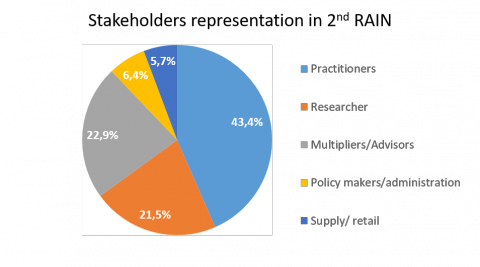
In January and February 2018, the second Regional Agroforestry Innovation Networks (RAINs) took place in all nine AFINET regions. In total 129 practitioners took part in these meetings. Their valuable input yielded an initial list of agroforestry innovations on which the AFINET partners will focus future dissemination. Talks and field visits organized during these RAINs were very instructive and highly appreciated by all RAIN participants.
Remember RAINs?
The RAINs are well-balanced groups of different stakeholders (pracititioners, researchers, multipliers/advisors, policy makers and suppliers/retailers) composed in each AFINET region. RAIN meetings are organised on a regular basis to support agroforestry innovations and knowledge transfer, starting from bottlenecks and problems experienced by practitioners.
In the first RAINs (summer 2017) the main agroforestry bottlenecks and challenges were identified for each region. It became clear that besides a few regional specific challenges, a lot of the bottlenecks are shared between the different regions. There is a need for more information on cost benefit analyses, on appropriate choice of species/varieties and on the demand, supply and marketing opportunities for all sorts of agroforestry systems and their products. Also the lack of practical guidelines and good practice examples is a common obstacle.
2nd RAIN meeting
The second RAINs aimed to further specify the identified bottlenecks from the 1st RAIN meeting, prioritising the most important ones using a survey within the AFINET regions. Interactions between RAIN stakeholders and the AFINET innovation brokers during this second meeting yielded an exhaustive initial list of innovations. This list will act as a guideline for the AFINET project partners indicating topics to focus the dissemination of best practices.
A total of 297 stakeholder were present at the 2nd RAIN meetings, averaging 33 participants per region and with a minimum of 12 and maximum of 93 attendees. In total, over 40% of participants were practitioners (farmers, landowners, foresters, contractors), while researchers and multipliers/advisors each represented around 20% of the participants.
 |
Survey confirms importance of bottlenecks 1st RAIN
Prior to the second RAIN meeting, all RAIN members across the different regions were asked to complete a survey in which they were asked to score the priority of eight common European challenges and make suggestions on how to address these bottlenecks. Spread over all nine regions 197 stakeholders completed the survey (about 70% of the RAIN members), with a minimum of 13 and a maximum of 43 respondents per region. Despite some small variability between stakeholder responses among countries, the overall average priority score for each bottleneck lies between 5 and 6. This clearly confirms that the previously identified challenges are seen as ‘very important’ to most stakeholders across Europe.
Table: Overall summary of the regional survey results of the priority European bottlenecks/challenges. Respondents gave scores ranging from 1 (being not important) upto 6 (very important). Regional averages for each of the bottlenecks are given in the table.
|
Bottleneck |
SP |
UK |
BE |
PT |
PL |
HU |
IT |
FR |
FI |
|
Improving Policy Support |
5,7 |
5,1 |
3,8 |
5,0 |
5,3 |
5,6 |
5,1 |
4,8 |
4,9 |
|
Optimal Combinations |
5,7 |
5,6 |
4,9 |
6,0 |
5,2 |
5,2 |
5,8 |
4,5 |
5,4 |
|
Practical guidelines |
5,5 |
5,6 |
4,6 |
5,0 |
5,2 |
5,4 |
5,2 |
4,9 |
5,3 |
|
Informing consumers |
5,5 |
4,9 |
4,5 |
5,0 |
5,2 |
5,4 |
5,6 |
4,3 |
4,6 |
|
Legislative uncertanty |
5,4 |
4,9 |
4,6 |
5,0 |
5,0 |
5,5 |
5,1 |
5,1 |
4,9 |
|
Cost/benefit insights |
5,4 |
5,4 |
3,9 |
5,0 |
5,4 |
5,1 |
5,4 |
4,5 |
5,1 |
|
Demonstration farms |
5,3 |
5,4 |
4,2 |
5,0 |
5,4 |
5,5 |
5,6 |
4,3 |
5,6 |
|
Value chain |
5,2 |
5,2 |
3,8 |
5,0 |
- |
5,2 |
5,4 |
5,2 |
5,1 |
Addressing the first bottlenecks
During the second RAIN meeting, the first bottlenecks were already addressed. Several instructive and inspiring talks were given by project partners, researchers and practitioners in each region. Content of these talks ranged from broad agroforestry topics (legislation, ongoing research, marketing opportunities provided by agroforestry…) to some more specific talks coming from firsthand on for example the cultivation and marketing of walnuts. In some regions the RAIN participants also went on a field visit to an agroforestry system or even got a demonstration of good practice on for example pruning of olive trees. Again a range of different systems were visited across the different RAINs including the combination of timber of walnut and cherry trees with sheep, the combination of organic vegetables and apple trees and the combination of fodder trees and livestock.











